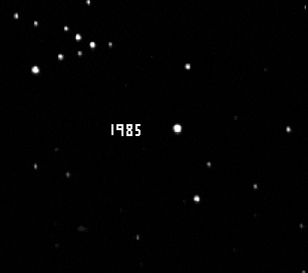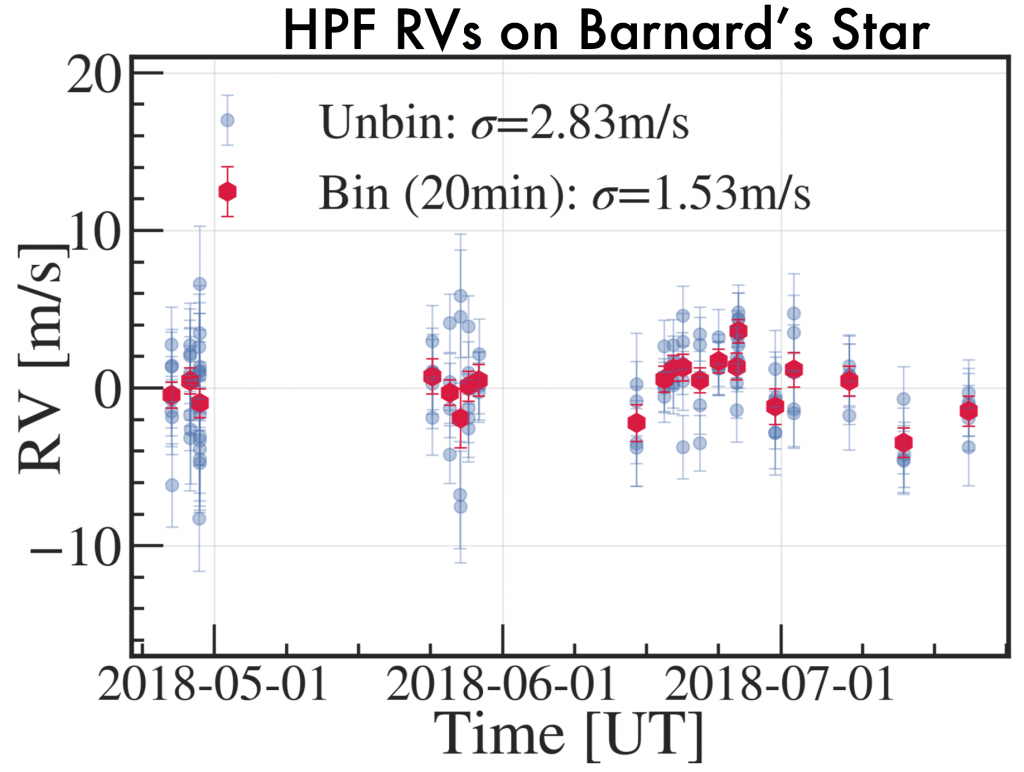We’ve been quiet…
Our last post, made about a year ago, shared our excitement at having delivered HPF to its permanent home on HET, and recording the instrument’s first data. Since then, we have been busy doing the hard work of “commissioning” the instrument. For an astronomical instrument, commissioning refers to a period of performance verification and fine-tuning that occurs once the instrument arrives at the telescope. Certain tests and adjustments can only be done in conjunction with the telescope, so some patience is required as the instrument team makes improvements before real science can begin.
We are happy to report that HPF has now been released to the HET community for full science operations! We have also collected enough data that we can start to evaluate the measurement precision of the spectrograph, and determine whether our on-sky performance matches our original project goals. Here, we will show you some of that data, and explain why we are confident that HPF will break new ground in the study of the nearest exoplanet systems. Technical details of this work can be found in an upcoming edition of Optica.
Barnard’s Star: the M Dwarf Standard
While the ultimate goal of any Doppler spectrograph is to find lots of exoplanets, boring is better during the commissioning phase. The only way to test the stability and precision of your end-to-end measurement system–from the telescope, through the fiber optics, and ultimately the optics and detector of the spectrograph–is to make repeated measurements of a star with little or no variability. That way, any variability seen in the measurements must be caused by the instrument, rather than the star itself. In other words, the less variability we measure in observations of our stable “standard star,” the better the instrument is performing.
For the M dwarf stars HPF is designed to target, the best standard star is also one of the most famous stars in the sky. Barnard’s star–named for the American astronomer E. E. Barnard–is the second-closest star system to the Sun (after the alpha Centauri triple system). It is a little more than 14 percent as massive as the Sun, which is typical of the stars HPF will survey for exoplanets.

Barnard’s star can be seen moving relative to background stars in this time-lapse image. Barnard’s star has the highest on-sky velocity of any star. (Image courtesy Steve Quirk).
Barnard’s star is extremely old–possibly as old as the Milky Way Galaxy itself. As such, it is rotating extremely slowly, and exhibits little of the stellar activity that causes radial velocity variability in other stars. That low variability makes it an excellent commissioning standard for HPF. Furthermore, its location near the celestial equator means it has been observed by telescopes in both the Northern and Southern Hemispheres, so we can compare our results to those of other spectrographs.
The Observations
The Hobby-Eberly Telescope is queue scheduled, meaning resident astronomers record data for multiple users over the course of a single night. This method of scheduling is ideal for repeated observations of a single star over time. From February through July of 2018, HPF recorded the spectrum of Barnard’s star on every night possible.
Our HPF observations kicked into high gear in May, when the Laser Frequency Comb (LFC) from our team members at NIST and CU was fully operational at the HET. The LFC is based on Nobel-prize-winning technology, and uses carefully modulated lasers and optics to create a perfectly uniform array of laser lines that can be used to provide an ultra-stable wavelength reference against which HPF measures Doppler shifts in a star’s spectrum. We discuss the LFC in more detail in a companion post.
By the time we shut down HPF for some post-commissioning maintenance, we had made 21 high-quality measurements of Barnard’s star using HPF with the LFC. These observations span 86 days, which is enough to quantify the baseline stability of the HPF system. Let’s take a look at the results:
The Results
We would be remiss if we did not emphasize that working all of the kinks out of an ultra-precise Doppler spectrograph is a years-long process, and we are far from done making improvements to the instrument and our analysis techniques. With that said, our early observations of Barnard’s star are extremely promising!

HPF radial velocities of Barnard’s star. Blue points represent individual spectra, while red points are the average of measurements made within a 20-minute series. The 1.5 meter per second precision is the best ever achieved in the near infrared!
Our current data series on Barnard’s star show a stability of around 1.5 meters per second, which is the best ever demonstrated on an infrared instrument. For comparison, the most stable measurements of Barnard’s star ever reported come from the HARPS spectrograph, and they check in at around 1.2 meters per second. Until now, HARPS has been the industry standard in ultra-precise Doppler spectroscopy, so for HPF–with its newer and more complicated infrared technology– to nearly match HARPS so soon after going on sky is a major accomplishment!
Long-time readers of this blog may recall that our goal measurement precision is 1 meter per second, while our current precision appears to be around 1.5 meters per second. What noise sources might be remaining? It is probably a combination of stellar activity, contamination from Earth’s atmosphere, small exoplanets, and some yet-to-be identified instrumental systematics. We are continuing to check everything in an effort to squeeze every last drop of precision out of HPF.
A Planet Around Barnard’s Star?
Just after we finished our commissioning observations on Barnard’s star, the Red Dots team announced they had discovered a candidate exoplanet orbiting Barnard’s star. The proposed planet, Barnard b, is around 3 times the mass of the Earth and takes 233 days to complete an orbit, so its Doppler signal is quite small. Nevertheless, HPF’s precision is good enough to at least see some trace of this planet, so what gives?
As it turns out, cosmic coincidence prevents us from having much information on Barnard b at this point. The orbit of the proposed planet is eccentric, which means the Doppler signal is more pronounced at some phases of its orbit than others. Through nothing but luck, our HPF-LFC observations completely missed the most dynamic section of the Barnard b phase curve.

The orbital model of Barnard b (blue), with HPF measurements (gold) folded to the orbital phase. Our measurements have not yet covered the maximum of the eccentric orbit.
Thus, while our HPF measurements do not rule out the proposed planet, they cannot yet confirm it, either. This is just one of many examples of how exoplanet detection is a data-intensive process!
Conclusion
HPF’s first year on sky is in the books, and things are looking quite promising! We are already setting new records for Doppler precision in the near-infrared, and continue to push towards even better stability.
Now, the fun part begins. HPF science operations officially started on December 1, 2018. Whereas Barnard’s star is one of the most familiar, well-studied stars in the sky, we will now expand our operations to examine stars about which relatively little is known. As always, we will share any exciting new results with you here.
We will continue to observe Barnard’s star, both to validate our long-term instrumental performance, and to learn more about any planets that may orbit this ancient star. It is as quiet as stars come, but it may still be harboring some exciting secrets.

 RSS - Posts
RSS - Posts